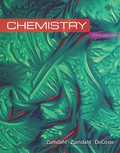
Concept explainers
Interpretation: For the given data, the final pressure and temperature in the container should be determined.
Concept introduction:
By combining the three gaseous laws namely Boyle’s law, Charles’s law and
According to ideal gas law,
Where,
P = pressure in atmospheres
V= volumes in liters
n = number of moles
R =universal gas constant (
T = temperature in kelvins
By knowing any three of these properties, the state of a gas can be simply identified with applying the ideal gas equation. For a gas at two conditions, the unknown variable can be determined by knowing the variables that change and remain constant and can be generated an equation for unknown variable from ideal gas equation.
Answer to Problem 65E
Answer
The pressure inside the container if it is heated to
The temperature inside the container if the excreted pressure be
The temperature inside the container if the excreted pressure be
Explanation of Solution
Explanation
According to ideal gas equation,
By rearranging the above equation,
Since R is a gas constant, and at constant n and V for a gas at two conditions the equation can be written as:
At constant volume and number of moles, for finding the equation for final pressure the above equation (1) becomes,
From the ideal gas equation, the equation for final pressure of gas for a gas at two conditions can be derived by knowing initial pressure (
The given data and its values.
To find out the final pressure of gas, it is needed to take and write the given data and substitute their values in the equation (2). For two conditions problem, units for P and V just needed to be the same units and it is not needed to convert the standard units. But in the case of pressure, it must be converted to the Kelvin.
The final pressure of gas can be determined by substituting the given values to the equation (2) that derived from ideal
The given data into the equation (2) to get the final pressure of gas,
Derive the equation for final temperature of gas from ideal gas equation for a gas at two conditions
According to ideal gas equation,
By rearranging the above equation,
Since R is a gas constant, and at constant n and V for a gas at two conditions the equation can be written as:
At constant volume and number of moles, for finding the equation for final temperature the above equation (1) becomes,
From the ideal gas equation, the equation for final pressure of gas for a gas at two conditions can be derived by knowing initial pressure (
The given data and its values to determine the temperature inside the container if the excreted pressure be
To find out the final temperature of gas, it is needed to take and write the given data and substitute their values in the equation (2). For two conditions problem, units for P and V just needed to be the same units and it is not needed to convert the standard units. But in the case of pressure, it must be converted to the Kelvin.
The given data into the equation (2) to get the final temperature of gas.
The final temperature of gas can be determined by substituting the given values to the equation (2) that derived from ideal gas law.
The given data and its values to determine the temperature inside the container if the excreted pressure is
To find out the final temperature of gas, it is needed to take and write the given data and substitute their values in the equation (2). For two conditions problem, units for P and V just needed to be the same units and it is not needed to convert the standard units. But in the case of pressure, it must be converted to the Kelvin.
Substitute the given data into the equation (2) to get the final temperature of gas.
The final temperature of gas can be determined by substituting the given values to the equation (2) that derived from ideal gas law.
Conclusion
The final temperature and pressure in the container is measured by ideal gas equation.
Want to see more full solutions like this?
Chapter 5 Solutions
EBK CHEMISTRY
- One step of glycolysis is a retro-aldol reaction (aldolase) to produce ATP.Below is the aldol reaction of the equilibrium. Show the mechanism for the base catalyzed reaction. *see imagearrow_forwardProvide the missing information. *see imagearrow_forwardWhy does the following reaction lead to poor yields? Correct the reaction. *see imagearrow_forward
- Provide the missing information. *see imagearrow_forwardDraw the mechanism (including all curved arrows for electron movement) showing how the maleicanhydride is attacked by the anthracene and formation of the final Diels Alder product.arrow_forwardProvide the missing information. *see imagearrow_forward
- Provide the missing information. *see imagearrow_forwardProvide the missing information. *see imagearrow_forwardI have a bottle of butanal that has been improperly used by lab workers. They allowed a traceamount NaOH (aq) to contaminate the bottle. What is now in my bottle of “butanal? What is the molecular name and functional group name? Draw the structure.arrow_forward
 Chemistry: The Molecular ScienceChemistryISBN:9781285199047Author:John W. Moore, Conrad L. StanitskiPublisher:Cengage LearningChemistry: Matter and ChangeChemistryISBN:9780078746376Author:Dinah Zike, Laurel Dingrando, Nicholas Hainen, Cheryl WistromPublisher:Glencoe/McGraw-Hill School Pub Co
Chemistry: The Molecular ScienceChemistryISBN:9781285199047Author:John W. Moore, Conrad L. StanitskiPublisher:Cengage LearningChemistry: Matter and ChangeChemistryISBN:9780078746376Author:Dinah Zike, Laurel Dingrando, Nicholas Hainen, Cheryl WistromPublisher:Glencoe/McGraw-Hill School Pub Co ChemistryChemistryISBN:9781305957404Author:Steven S. Zumdahl, Susan A. Zumdahl, Donald J. DeCostePublisher:Cengage Learning
ChemistryChemistryISBN:9781305957404Author:Steven S. Zumdahl, Susan A. Zumdahl, Donald J. DeCostePublisher:Cengage Learning
 Chemistry: An Atoms First ApproachChemistryISBN:9781305079243Author:Steven S. Zumdahl, Susan A. ZumdahlPublisher:Cengage Learning
Chemistry: An Atoms First ApproachChemistryISBN:9781305079243Author:Steven S. Zumdahl, Susan A. ZumdahlPublisher:Cengage Learning World of Chemistry, 3rd editionChemistryISBN:9781133109655Author:Steven S. Zumdahl, Susan L. Zumdahl, Donald J. DeCostePublisher:Brooks / Cole / Cengage Learning
World of Chemistry, 3rd editionChemistryISBN:9781133109655Author:Steven S. Zumdahl, Susan L. Zumdahl, Donald J. DeCostePublisher:Brooks / Cole / Cengage Learning





